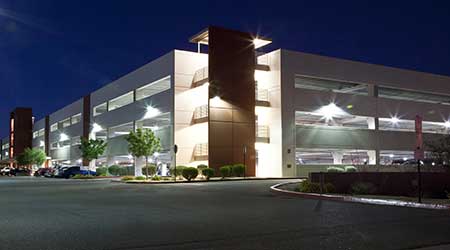Parking Structure Assessment: How to Do Material Sampling
Here is how to do material sampling tests to evaluate the condition of concrete and embedded steel elements.
A parking structure assessment may include on-site testing, material sampling, and laboratory analysis to evaluate the condition of concrete and embedded steel elements.
Non-invasive tests, which require minimal or no removal of materials, may include:
• Chain drag survey: Used to detect delaminations in concrete parking decks. Involves pulling heavy chains along the parking deck surface to listen for the characteristic hollow sound of subsurface voids.
• Joint movement survey: Identifies joints between precast concrete members that contain fractured connections. As a vehicle drives across a joint, the joint is monitored for discernable movement that would indicate fractured connections.
• Half-cell potential testing: Determines the electrochemical properties of embedded steel by measuring its electrical potential. The greater the difference in charge from one point on the steel bar to the next, the greater the risk that corrosion is occurring. Requires removal of the concrete cover over reinforcing, to access the steel bars.
Invasive tests demand some degree of destructive probing, whether to extract materials for off-site analysis, or to reveal concealed conditions. These often include:
• Probes: Removal of existing materials (concrete, sealant, etc.) to observe underlying construction details and conditions.
• Chloride sampling: Determines chloride concentrations within the concrete, which indicate the potential for corrosion of embedded steel elements. Dust samples may avoid the need for destructive testing, but in some cases, concrete core extraction may be specified, to obtain additional information on concrete strength and composition.
• Petrographic analysis: Using concrete cores, petrographic analysis evaluates concrete strength, air entrainment, aggregate type and distribution, and evidence of shrinkage, settlement, corrosion, secondary deposits, and deleterious products of chemical reactions. Also offers insight into concrete composition, including water-to-cement ratio, porosity, binder and paste content, and depth of carbonation, all of which indicate the overall soundness and durability of the concrete.
• Welding analysis: For precast concrete garages, where connection failure is a common concern, extraction of welded assemblies may be warranted, to determine the quality of welding or the materials used.
Turnaround time for laboratory tests can vary, so it is best to obtain samples early in the investigation process. Typically, chloride ion testing takes just one or two weeks, but a full petrographic analysis can take four to six weeks or more. When determining the overall timeline for a parking garage condition assessment, it is important to consider how the lead time for sample analysis impacts production of the final report.
Related Topics:














